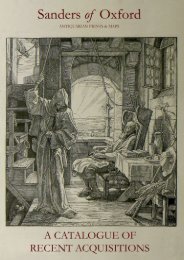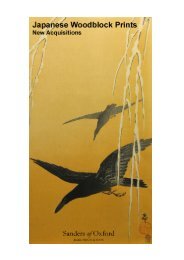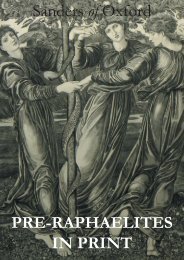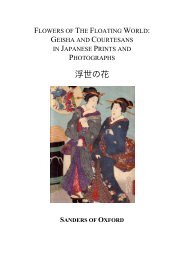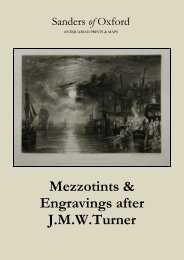«Heading» - International League of Antiquarian Booksellers
«Heading» - International League of Antiquarian Booksellers
«Heading» - International League of Antiquarian Booksellers
You also want an ePaper? Increase the reach of your titles
YUMPU automatically turns print PDFs into web optimized ePapers that Google loves.
Cambridge<br />
155. The Colleges <strong>of</strong> Cambridge<br />
Lithograph in colours<br />
Fred Taylor<br />
Published by British Railways. Printed in Great Britain;<br />
Baynard Press. Published by the Raileay Executive<br />
(Eastern Region) (AR 1043) c. 1950.<br />
Image 958 x 1215 mm, Sheet 1070 x 1328 mm<br />
Framed<br />
The story <strong>of</strong> railways in Britain is reflected in the<br />
development <strong>of</strong> the railway poster. This commercial art<br />
form illustrates the major changes that have occurred in<br />
British society over the years and captures the spirit and<br />
character <strong>of</strong> British life. They are social documents <strong>of</strong><br />
British culture, illustrating the changing styles <strong>of</strong> art,<br />
patterns <strong>of</strong> holidaymaking, urban and rural landscapes,<br />
architecture and fashion. They also reflect the<br />
development <strong>of</strong> railway companies and their design and<br />
advertising standards. It is hardly surprising that the<br />
"Golden Age" <strong>of</strong> British railway posters coincided with<br />
the quarter-century following the amalgamation in 1923<br />
<strong>of</strong> almost all <strong>of</strong> the numerous small independent<br />
companies into what came to be known as the "Big<br />
Four"railways: the Great Western (GWR); the London,<br />
Midland, and Scottish (LMS); the London and North<br />
East (LNER); and the Southern (SR). The end <strong>of</strong> the<br />
Great War saw Britain with a public eager to travel -<br />
and possessing a well-developed taste for the poster as a<br />
medium <strong>of</strong> advertising. In the latter case the war itself<br />
provided continuity for initiatives that began in<br />
peacetime, for the recruiting and saving and funding<br />
campaigns needed to vanquish the Hun were waged<br />
largely on the hoardings.<br />
Nor is it surprising that the main visual thrust <strong>of</strong> the<br />
railway poster campaigns during these years was<br />
directed towards the anticipated delights <strong>of</strong> journey's<br />
end, and copies <strong>of</strong> posters were routinely <strong>of</strong>fered to -<br />
and eagerly purchased by - the public, some <strong>of</strong> whom<br />
might indeed have to settle more <strong>of</strong>ten for an idyllic<br />
image <strong>of</strong> Britain's coasts or mountains in their rooms<br />
than for the real thing.<br />
medal for his posters, and a travelling scholarship to<br />
study in Italy. At some point working in the Waring and<br />
Gillow Studio, Taylor was a poster artist, illustrator,<br />
decorator and a watercolourist. Particularly noted as a<br />
poster artist from 1908 to the 1940s, and was regularly<br />
commissioned by the LNER, EMB and shipping<br />
companies. Taylor also exhibited regularly at the Royal<br />
Academy, and other provincial societies. Taylor's<br />
designs frequently referred to architectural subjects.<br />
During the Second World War, Taylor was employed<br />
on naval camouflage. He also executed commissions for<br />
London Transport, including 'Back Room Boys', where<br />
the underlying concept and use <strong>of</strong> central image with a<br />
surrounding border were probably taken from A S<br />
Hartrick's series <strong>of</strong> lithographs on war work called<br />
Playing the Game, 1918, although 'their finely balanced<br />
colouring and their superb draughtsmanship are peculiar<br />
to Taylor at his best'. Married to Florence R Sarg, with a<br />
son and a daughter, Taylor is also remembered for his<br />
decorating work, most notably for ceilings for the<br />
former Underwriter's Room at Lloyds <strong>of</strong> London, and<br />
murals for Austin Reed's red laquer room in 1930. He<br />
was also the author <strong>of</strong> a number <strong>of</strong> publications.<br />
Information taken from: Livingston, A. and Livingston,<br />
I., Dictionary <strong>of</strong> Graphic Design and Designers, 1992,<br />
p.187, London Transport Museum Database, February<br />
2000, quoting Riddell, 1994, Darracott, J. and L<strong>of</strong>tus,<br />
B., Second World War Posters, 1981 (1972), p.55<br />
Condition: numerous creases to left and right margins,<br />
centre <strong>of</strong> image and title space (these are not visable in<br />
the image on our website)<br />
[25998]<br />
£900<br />
Johannes Kip<br />
Johannes Kip (1653-1722) was a draughtsman and<br />
engraver, who worked first in his native Amsterdam<br />
before moving to London at the end <strong>of</strong> the seventeenth<br />
century. He did portraits, views, and book illustrations.<br />
His most important work was this lovely and<br />
informative series <strong>of</strong> bird's-eye views <strong>of</strong> English<br />
country seats. Kip originally collaborated on this project<br />
with a fellow Dutch artist, Leonard Knyff, Knyff doing<br />
the drawings and Kip the etchings. But as the project<br />
developed, Kip created his own drawings as well as<br />
doing the etchings.<br />
From The Ancient & Present State <strong>of</strong> Gloucestershire<br />
published by Sir Robert Atkyns, Knt in 1768.<br />
Fred Taylor was born in London on March 22 1875, the<br />
son <strong>of</strong> William Taylor. Taylor studied briefly at<br />
Goldsmith's College, London, where he won a gold




